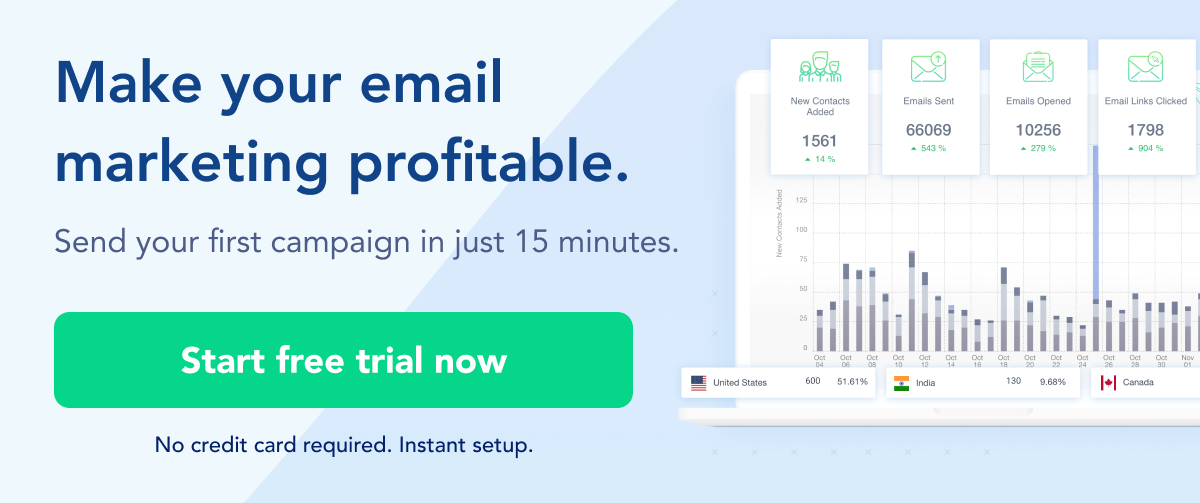Waves of new marketing strategies may pop up every year, but email campaigns remain one of the most effective options to date. In fact, studies show that most smartphone users prefer to receive brand communication via email, and the average ROI for email marketing is $36 for every $1 spent.
Compared to web chats, phone calls, and even social media messaging, email has withstood the test of time as the preferred choice of direct consumer communication.
But just like every marketing strategy, there are effective and ineffective ways to approach email campaigns.
Below, we’ll unpack five best practices for delivering email campaigns to business emails, as well as highlight some common missteps in the process.
Table of Contents
What Does Delivering Email Campaigns To Business Emails Mean?
An email campaign is an organized marketing effort in which a brand contacts multiple recipients via newsletters or broadcast-like emails. Delivering email campaigns to business emails simply means using this marketing strategy to reach a wide net of consumers through their business email addresses.
However, email marketing and campaigns can be used to reach a vast array of different consumer demographics. Interestingly enough, regardless of age or location, email is still the most effective way to reach consumers with new information.
Swift, cheap, and convenient, the humble email system has been the driving force behind many marketing strategies over time.
Ever since email replaced manual mail systems as a method of long-distance communication, it has become an absolute staple for individuals and organizations across the globe. And now, it has become an indispensable tool that most businesses rely on as their primary source of communication engagement.
Email Campaign Best Practices: Making The Most Of Your Marketing Strategy
When it comes to a successful email campaign, there are a few core practices to keep in mind. Not only does your email content need to be relevant and stimulating to customers, but it also needs to be secure and closely monitored to track results.
If your business is new to email campaign strategies, having a few helpful guidelines to point you in the right direction can make a world of difference.
Here are five best practices to implement:
1. Use Permission-Based Lists
In this context, a permission-based list is a list of email contacts that have given you permission to send them marketing-related emails on a regular basis. Using these lists is not only a more ethical way to approach marketing, but it also ensures that customers only receive content that is relevant to them individually.
- Build and maintain your email list with permission-based subscribers
- Ensure that all recipients have explicitly opted in to receive emails from your business
- Avoid purchasing email lists or sending unsolicited emails, as this can result in high bounce rates and spam complaints.
Every business must obtain a consumer’s permission to send marketing content. Failure to do so will likely result in mass unsubscriptions and a negative perception of your business.There are also legal and regulatory guidelines that govern marketing emails to ensure that the recipients are protected.
In the US, the CAN-SPAM Act outlines how permission must be granted and the steps that must be followed to ensure that any unsubscribe requests are adhered to promptly.
In the UE, the General Data Protection Regulation (GDPR) Act only allows for email marketing if the recipient has opted in, and they must be able to opt-out. Both Acts also protect recipients’ personal data.
These are just two examples of the governance that applies to email marketing. If you’re marketing to businesses operating outside of these spheres, you need to ensure you adhere to their local laws, too.
2. Segmentation and Personalization
Personalization, including using the recipient's name and customizing content, can significantly improve engagement. In fact, personalized emails have an open rate of 29% and a wildly impressive click-through rate of 41%. Compared to non-personalized emails (which have an open rate of 21% and a click-through rate of just 2.91%), these are astonishing and significant indicators that personalization triumphs.
- Segment your email list based on relevant criteria, such as industry, job role, or past engagement
- Tailor your email content to the specific interests and needs of each segment
- Invest in software that tracks consumer interests in order to serve people content that matches the products, services, or events that they are inclined to.
Personalization can take many different forms. It could involve shopping suggestions, using people’s names to address their newsletters, or simply highlighting news that is relevant to their search history.
For personalizing emails for businesses you can include dynamic content that directly addresses their sector or industry’s pain points, prompt a reaction by asking for feedback, or even congratulating them on a specific milestone. The overarching aim of personalization is to trigger a reaction and create a connection that encourages interaction.
3. Authentication and Sender Reputation
One of the best ways to improve email campaign deliverability and bolster domain credibility is to utilize authentication, encryption, and sender reputation protection. Both for your brand and its network of contacts. This will prevent dangerous scams like phishing and malware from intruding on your system.
The more protected and secure your email campaign is, the higher your open and click-through rates will be. This further helps boost your online credibility and can even improve search engine rankings.
- Implement email authentication protocols like SPF (Sender Policy Framework), DKIM (DomainKeys Identified Mail), and DMARC (Domain-based Message Authentication, Reporting, and Conformance).
- Run regular tests to ensure that your authentication and security measures are fully intact and performing well so that any bugs or external threats are detected immediately.
These measures help verify your email's authenticity and improve your sender reputation. A strong sender reputation enhances email deliverability.
4. Optimize Email Content
It’s important to constantly consider what can be done to improve and innovate the content you serve to consumers.
Don’t stop looking for refreshing, creative, and interesting ways to liven up your content and make it more engaging and enticing for customers to interact with.
- Create well-designed and mobile-responsive email templates
- Ensure that your emails have clear and compelling subject lines and content
- Avoid using spammy or excessive promotional language
- Focus on providing valuable and relevant information to your business audience.
Optimizing your email content should be an ongoing process.
Use data analytics to discover what kind of content your consumers like best and then implement that content into future content campaigns. Be relentless in your pursuit of improvement.
Some of the data analytics you should track in this regard include:
- Click Through Rate (CTR)
- Open Rate
- Conversion Rate
- Bounce Rate
- Unsubscribe Rate
5. Testing and Monitoring
Before sending your email campaign, conduct testing to check for issues related to formatting, links, and deliverability. This is an essential part of email campaign optimization and maintenance over time.
Testing can be achieved in a variety of ways; the simplest is sending a test email to a dummy brand account that you create specifically for testing purposes to make sure that your content is formatted correctly and includes all the necessary details. You can also use data analytics.
- Monitor email engagement metrics, including open rates, click-through rates, and conversion rates
- Address any delivery or engagement issues promptly, and use these insights to refine future campaigns
Monitoring the success, functionality, and deliverability of your email campaigns is crucial for retaining positive and sustainable interest from business emails and any other consumers who are on your roster.
Common Mistakes To Avoid With An Email Campaign
“Customers don’t sign up for email—they sign up for your brand.” - Bob Frady, Co-founder and Vice President of Guidewire HazardHub
While email campaigns can be a very efficient and relevant strategy for delivering key information and news to consumers, one or two small mistakes can derail their success. Most consumers are happy to receive emails from brands they trust, but failure to fulfill their expectations can result in a loss of loyalty and a drop in retention.
Fortunately, other businesses before you have already made many mistakes with their email campaigns. This means you have the privilege of learning from them. Here are five of the most common mistakes brands make when implementing an email campaign:
- Using too many emojis – Surprisingly, emojis do have a place in the world of email campaign subject lines, but never too many. This can read as spammy or juvenile, especially for business emails. Sticking to one or two emojis is best as they deliver impact without appearing unprofessional.
- Not personalizing emails – With as many as 90% of marketers agreeing that personalization significantly boosts business profitability, it’s clear that consumers love personalization, and that’s not likely to change anytime soon. Homogenous, uniform emails are simply not engaging enough for today’s consumers, which is why your brand should make customized tags, products, offerings, news, and services as frequent and organic as possible. Your stats and your audience will thank you.
- Lack of optimization for mobile devices – 0.9 billion people use desktops to open emails. But guess how many use their mobiles? 1.7 billion.Mobile devices far surpass desktops in email activity, so your brand should focus on mobile devices when designing content and usability for these campaigns.
- Sending too many or too few emails – Overly frequent emails feel spammy and annoying to consumers. However, infrequent emails may render your brand forgotten and irrelevant.
One email a week or two to three a month is a good guideline as they’re not frequent enough to be a nuisance, but they’re not too frequent for you to be forgotten.
- Using spam words in subject lines – "free,” "guaranteed,” “easy money,” and “limited time offer” may seem like fairly innocuous words, but they lack professional tact and, due to their close association with spam mail, may get flagged or blacklisted by your email service holder.
When creating a plan of action for future email campaigns to business emails, make sure your team understands what practices to avoid and which to embrace. These tips should suffice as a comprehensive template for developing a world-class, high ranking email marketing strategy.
Engage & Excel: Get Your Business Email Campaigns Noticed
“Email has an ability many channels don’t: creating valuable personal touches—at scale.” - David Newman, marketing expert and author
With the right approach, email campaigns can play an instrumental role in engagement with your business’s customers.
With such a consistently high volume of global consumers using email to connect and communicate with their favorite brands, taking a smart approach to email marketing is one of the best ways to ensure yours remains relevant and active with its target audience.
With a bit of personalization, segmentation, authentication, and robust testing, your business can develop a much stronger and more operative relationship with consumers.



